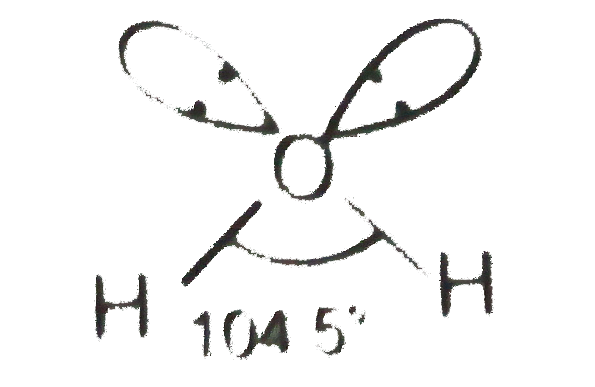Give reason for the following.
a) Covalent bonds are directional bonds while ionic bonds are non-directional.
b) Wate molecules has bent whereas carbon dioxide molecule is linear.
c) Ethyne molecule is linear.
The correct Answer is:a
a) A covalent bond is formed by the overlap of atomic orbitals. The direction of overlapping gives the direction of bond. In ionic bond, the electrostatic field of an ion is non-directional.
Each positive ion is surrounded by a number of anions in any direction depending upon its size and vice-versa. That's why covalent bonds are directional bonds while ionic bonds are non-directional.
b) In H2O oxygen atom is sp3 hybridised with two lone pairs. The four sp3 hybridised orbitals acquire a tetrahedral geometry with two corners occupied by hydrogen atoms while other two by the lone pairs.
The bond angle is reduced to 104.5∘ from 109.5∘ due to greater repulsive forces between Ip-Ip and the molecule thus acquires a V-shape or bent structure (angular structure )

In CO2 molecule, carbon atom in sp-hybridised. The two sp hybrid orbitals are oriented in opposite direction forming an angle of 180∘.

Thats, why H2O molecule has bent structure whereas CO2 molecule is linear.
c) In ethyne molecule, both the carbon atoms are sp hybridised, having two unhybridised orbitals, i.e, 2px and 2py. The two sp hybrid orbitals of both the carbon atoms are oriented in opposite direction froming an angle of 180∘
H−Cσ≡2π−bondC−H
That's why ethyne molecule is linear.
Topper's Solved these Questions
- BOOK - NCERT EXEMPLARCHAPTER - CHEMICAL BONDING AND MOLECULAR STRUCTUREEXERCISE - Matching the columns5videos
CHEMICAL BONDING AND MOLECULAR STRUCTURE
- BOOK - NCERT EXEMPLARCHAPTER - CHEMICAL BONDING AND MOLECULAR STRUCTUREEXERCISE - Assertions and Reasons3videos
CHEMICAL BONDING AND MOLECULAR STRUCTURE
- BOOK - NCERT EXEMPLARCHAPTER - CHEMICAL BONDING AND MOLECULAR STRUCTUREEXERCISE - Long Answer type questions9videos
CHEMICAL BONDING AND MOLECULAR STRUCTURE
- BOOK - NCERT EXEMPLARCHAPTER - CLASSIFICATION OF ELEMENTS AND PERIODICITY IN PROPERTIES.EXERCISE - Long answer types question7videos
CLASSIFICATION OF ELEMENTS AND PERIODICITY IN PROPERTIES.
Similar Questions
Give reasons for the following :
(i) Covalent bonds are directional while ionic bonds are non-directional.
(ii) Water molecule has bent structure whereas carbon dioxide molecule is linear.
(iii) Etyne molecule is linear.View SolutionGive reasons for the following :
(i) Covalent bonds are directional while ionic bonds are non-directional.
(ii) Water molecule has bent structure whereas carbon dioxide molecule is linear.
(iii) Etyne molecule is linear.View Solution
Knowledge Check
- Question 1 - Select One
How many double bonds are present in carbon dioxide molecule?
AOneBTwoCThreeDFour - Question 2 - Select One
Which of the following molecules has both covalent and ionic bond
ACH3ClBNH4ClCHClDBeCl2 - Question 3 - Select One
Which of the following molecules has hargest bond angle ?
AH2OBNH3CCH4DCO2
Covalent bonds are non-directional bonds.
View SolutionIonic bonds are non-directional while covalent bonds are directional.
View SolutionGive reason for the following :
All five bonds in PCl5 molecule are not equivalent.View SolutionEach carbon - oxygen bond in carbon dioxide molecule is polar but the molecule itself is non - polar. Explain.
View SolutionWhich of the following molecules has hargest bond angle ?
View Solution
